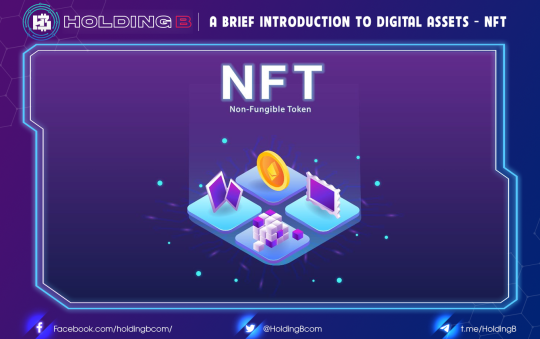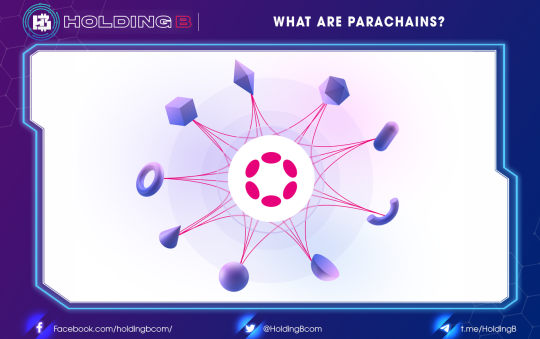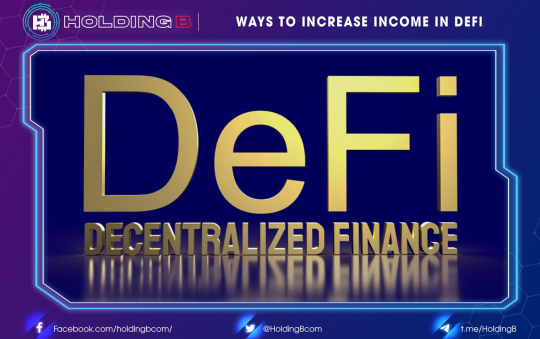WHAT IS ETHEREUM

Ethereum is a cryptocurrency (cryptocurrency, virtual currency or digital currency) developed on the basis of Blockchain technology. Ethereum is built on a private Blockchain, but still basically relies on the source code of Bitcoin and has more improvements than the “older brother” that went before. The Ethereum coin was created by Vitalik Buterin in 2013 with the aim of overcoming the disadvantages of Bitcoin.
Ethereum is a decentralized, open-source blockchain with smart contract functionality. Ether (ETH or Ξ) is the native cryptocurrency of the platform. Amongst cryptocurrencies, Ether is second only to Bitcoin in market capitalization.
Ethereum was conceived in 2013 by programmer Vitalik Buterin. Additional founders of Ethereum included Gavin Wood, Charles Hoskinson, Anthony Di Iorio, and Joseph Lubin. In 2014, development work commenced and was crowdfunded, and the network went live on 30 July 2015. The platform allows anyone to deploy permanent and immutable decentralized applications onto it, with which users can interact. Decentralized finance (DeFi) applications provide a broad array of financial services without the need for typical financial intermediaries like brokerages, exchanges, or banks, such as allowing cryptocurrency users to borrow against their holdings or lend them out for interest. Ethereum also allows for the creation and exchange of NFTs, which are non-interchangeable tokens connected to digital works of art or other real-world items and sold as unique digital property. Additionally, many other cryptocurrencies operate as ERC-20 tokens on top of the Ethereum blockchain and have utilized the platform for initial coin offerings.
Ethereum has started implementing a series of upgrades called Ethereum 2.0, which includes a transition to proof of stake and aims to increase transaction throughput using sharding.
ETHEREUM HISTORY
The idea was born with Mastercoin
Ethereum was initially described in a white paper by Vitalik Buterin, a programmer and co-founder of Bitcoin Magazine, in late 2013 with a goal of building decentralized applications. Buterin argued to the bitcoin core developers that Bitcoin and blockchain technology could benefit from other applications besides money and needed a more robust language for application development that could lead to attaching real-world assets, such as stocks and property, to the blockchain. In 2013, Buterin briefly worked with eToro CEO Yoni Assia on the Colored Coins project and drafted its white paper outlining additional use cases for blockchain technology. However, after failing to gain agreement on how the project should proceed, he proposed the development of a new platform with a more robust scripting language—a Turing-complete programming language —that would eventually become Ethereum.
Ethereum was announced at the North American Bitcoin Conference in Miami, in January 2014. During the conference, Gavin Wood, Charles Hoskinson, and Anthony Di Iorio (who financed the project) rented a house in Miami with Buterin to develop a fuller sense of what Ethereum might become. Di Iorio invited friend Joseph Lubin, who invited reporter Morgen Peck, to bear witness. Peck subsequently wrote about the experience in Wired. Six months later the founders met again in a house in Zug, Switzerland, where Buterin told the founders that the project would proceed as a non-profit. Hoskinson left the project at that time and soon after founded IOHK, a blockchain company responsible for Cardano.
Ethereum has an unusually long list of founders. Anthony Di Iorio wrote: “Ethereum was founded by Vitalik Buterin, Myself, Charles Hoskinson, Mihai Alisie & Amir Chetrit (the initial 5) in December 2013. Joseph Lubin, Gavin Wood, & Jeffrey Wilcke were added in early 2014 as founders.”
Vitalik Buterin – the father of Ethereum
Development
Formal development of the software began in early 2014 through a Swiss company, Ethereum Switzerland GmbH (EthSuisse). The basic idea of putting executable smart contracts in the blockchain need to be specified before the software could be implemented. This work was done by Gavin Wood, then the chief technology officer, in the Ethereum Yellow Paper that specified the Ethereum Virtual Machine. Subsequently, a Swiss non-profit foundation, the Ethereum Foundation (Stiftung Ethereum), was created as well. Development was funded by an online public crowd sale from July to August 2014, with the participants buying the Ethereum value token (Ether) with another digital currency, Bitcoin. While there was early praise for the technical innovations of Ethereum, questions were also raised about its security and scalability.
In January 2018, Ethereum was the second-largest cryptocurrency in terms of market capitalization, behind Bitcoin. As of 2021, it maintained that relative position.
In 2019, Ethereum Foundation employee Virgil Griffith was arrested by the US government for presenting at a blockchain conference in North Korea.
On 27 August 2021, the blockchain experienced a brief fork that was the result of clients running different incompatible software versions.
The DAO Hack Incident
In 2016, a decentralized autonomous organization called The DAO, a set of smart contracts developed on the platform, raised a record US$150 million in a crowd sale to fund the project. The DAO was exploited in June 2016 when US$50 million of DAO tokens were stolen by an unknown hacker. The event sparked a debate in the crypto-community about whether Ethereum should perform a contentious “hard fork” to reappropriate the affected funds. It resulted in the network splitting into two blockchains: Ethereum with the theft reversed and Ethereum Classic which continued on the original chain. The hard fork created a rivalry between the two networks. After the hard fork, Ethereum subsequently forked twice in the fourth quarter of 2016 to deal with other attacks.
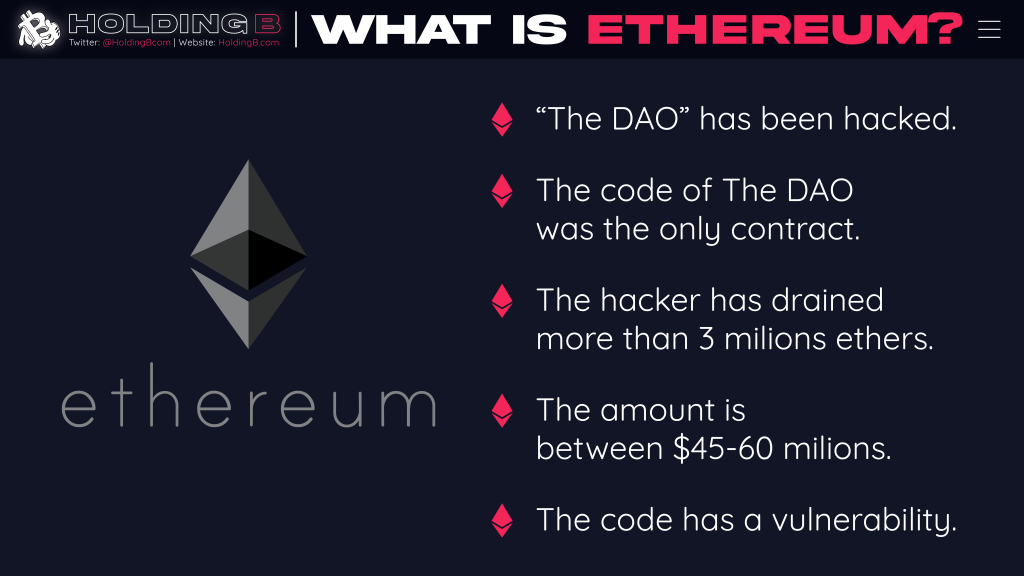
Hard Fork Ethereum
Hours before the soft fork was approved, a few community members discovered a bug that made Ethereum’s network vulnerable to DoS (attack of service) attacks.
To protect the network, the Ethereum community has agreed to the only option: The Hard Fork Ethereum – change the rules and regulations being applied on the Ethereum blockchain to make blocks, transactions translations confirmed by the old rule become invalid.
A hard fork is the last resort to both recover the stolen funds in the “child DAO”, and help the Ethereum network to avoid the risk of DoS attack. The entire Ethereum community has decided to conduct a hard fork at block 1,920,000. This is the block before the “child DAO” split from The DAO.
Although the lost funds were recovered, the consequences of the hard fork caused Ethereum’s network to split in two – Ethereum and Ethereum Classic.
WHAT IS ETHER ?
Unfortunately, most of us are not right to call Ethereum a cryptocurrency, it is rather a Blockchain platform, but because crypto exchanges listed on CoinMarketCap or exchanges are used.” Ethereum” should make people understand that.
Ether (ETH) is the cryptocurrency generated by the Ethereum protocol as a reward to miners in a proof-of-work system for adding blocks to the blockchain. It is the only currency accepted in the payment of transaction fees, which also go to miners. The block reward together with the transaction fees provides the incentive to miners to keep the blockchain growing (i.e. to keep processing new transactions). Therefore, ETH is fundamental to the operation of the network. Each Ethereum account has an ETH balance and may send ETH to any other account. The smallest subunit of ETH is known as a Wei and is equal to 10−18 ETH. Ether is often erroneously referred to as “Ethereum”.
Ether is listed on exchanges under the currency code ETH. The Greek uppercase Xi character (Ξ) is sometimes used for its currency symbol.[citation needed]
The shift to Ethereum 2.0 may reduce the issuance rate of Ether. There is currently no implemented hard cap on the total supply of Ether.
Comparison to Bitcoin
Bitcoin’s primary use case is that it is a store of value and a digital currency. Ether can also be used as a digital currency and store of value, but the Ethereum network makes it also possible to create and run decentralized applications and smart contracts. Ethereum blocks are validated approximately every 12 seconds on Ethereum as opposed to approximately every 10 minutes on Bitcoin. Additionally, Bitcoin has a fixed supply of 21,000,000 coins, whereas Ethereum has no supply cap. Ethereum and Bitcoin are both mined through proof-of-work and can be purchased on cryptocurrency exchanges.
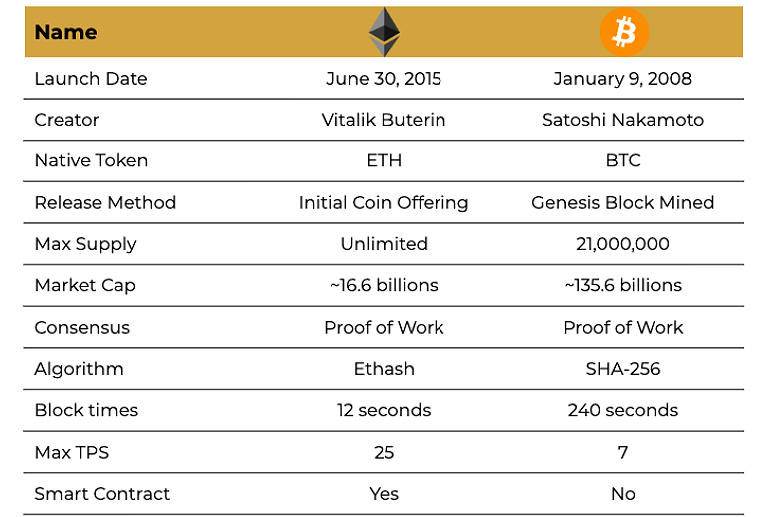
In addition, as seen on the comparison table, there are some technical differences between Ethereum and Bitcoin such as:
Total Supply: While Bitcoin’s total supply is fixed at 21 million BTC, Ethereum’s total supply is not fixed.
– Algorithm: Although the Proof of Work (PoW) consensus mechanism is similar, Ethereum uses the Ethash algorithm, which is different from Bitcoin (SHA-56).
–Transaction per seconds: Bitcoin’s transaction speed is only about 7 TPS / sec, this number of Ethereum is about 20-25 TPS / s, nearly 3 times that of Bitcoin.
–How it first appeared: The first Bitcoin appeared after Satoshi Nakamoto mined the first block (Genesis Block) of the Bitcoin blockchain. Meanwhile, Ethereum came about through an ICO after pre-mining nearly 72 million ETH.
–Founder: The founder of Bitcoin is Satoshi Nakamoto, an anonymous individual or organization. The founder of Ethereum is Vitalik Buterin, a Canadian programmer (identifier).
ACCOUNTS
There are two types of accounts on Ethereum: user accounts (also known as externally-owned accounts) and contracts. Both types have an ETH balance, may send ETH to any account, may call any public function of a contract or create a new contract, and are identified on the blockchain and in the state by their address.
User accounts are the only type that may create transactions. For a transaction to be valid, it must be signed using the sending account’s private key, the 64-character hexadecimal string from which the account’s address is derived. The algorithm used to produce the signature is ECDSA. Importantly, this algorithm allows one to derive the signer’s address from the signature without knowing the private key.
Contracts are the only type of account that has associated code (a set of functions and variable declarations) and contract storage (the values of the variables at any given time). A contract function may take arguments and may have return values. Within the body of a function, in addition, to control flow statements, a contract’s code may include instructions to send ETH, read from and write to its storage, create temporary storage (memory) that dies at the end of the function, perform arithmetic and hashing operations, call its own functions, call public functions of other contracts, create new contracts, and query information about the current transaction or the blockchain.
HOW DOES ETHEREUM WORK ?
In Ethereum, all smart contracts are stored publicly on every node of the blockchain, which has costs. Being a blockchain means it is secure by design[clarification needed] and is an example of a distributed computing system with high Byzantine fault tolerance. The downside is that performance issues arise in that every node is calculating all the smart contracts in real-time, resulting in lower speeds. As of January 2016, the Ethereum protocol could process about 25 transactions per second. In comparison, the Visa payment platform processes 45,000 payments per second leading some to question the scalability of Ethereum. On 19 December 2016, Ethereum exceeded one million transactions in a single day for the first time. Visa has also signaled interest in processing NFT and Ethereum transactions.
Ethereum engineers have been working on sharding the calculations, and the next step (Ethereum 2) was presented at Ethereum’s Devcon 3 in November 2017.
Ethereum’s blockchain uses Merkle trees, for security reasons, to improve scalability, and to optimize transaction hashing. As with any Merkle tree implementation, it allows for storage savings, set membership proofs (called “Merkle proofs”), and light client synchronization. The network has faced congestion problems, such as in 2017 in relation to Cryptokitties.

APPLICATIONS
The EVM’s instruction set is Turing-complete. Popular uses of Ethereum have included the creation of fungible (ERC20) and non-fungible (ERC721) tokens with a variety of properties, crowdfunding (e.g. initial coin offerings), decentralized finance, decentralized exchanges, decentralized autonomous organizations (DAOs), games, prediction markets, and gambling.
Contract source code
Ethereum’s smart contracts are written in high-level programming languages and then compiled down to EVM bytecode and deployed to the Ethereum blockchain. They can be written in Solidity (a language library with similarities to C and JavaScript), Serpent (similar to Python, but deprecated), Yul (an intermediate language that can compile to various different backends – EVM 1.0, EVM 1.5, and eWASM are planned), LLL (a low-level Lisp-like language), and Mutan (Go-based, but deprecated). There was also[when?] a research-oriented language under development called Vyper (a strongly-typed Python-derived decidable language).[citation needed] Source code and compiler information are usually published along with the launch of the contract so that users can see the code and verify that it compiles to the bytecode that is on-chain.
One issue related to using smart contracts on a public blockchain is that bugs, including security holes, are visible to all but cannot be fixed quickly. One example of this is the 2016 attack on The DAO, which could not be quickly stopped or reversed.
There is ongoing research on how to use formal verification to express and prove non-trivial properties. A Microsoft Research report noted that writing solid smart contracts can be extremely difficult in practice, using The DAO hack to illustrate this problem. The report discussed tools that Microsoft had developed for verifying contracts, and noted that a large-scale analysis of published contracts is likely to uncover widespread vulnerabilities. The report also stated that it is possible to verify the equivalence of a Solidity program and the EVM code.
ERC-20 Tokens
The ERC-20 (Ethereum Request for Comments 20) Token Standard allows for fungible tokens on the Ethereum blockchain. The standard, proposed by Fabian Vogelsteller in November 2015, implements an API for tokens within smart contracts. The standard provides functions including the transfer of tokens from one account to another, getting the current token balance of an account, and getting the total supply of the token available on the network. Smart contracts that correctly implement ERC-20 processes are called ERC-20 Token Contracts and help keep track of the created tokens on Ethereum. Numerous cryptocurrencies have launched as ERC-20 tokens and have been distributed through initial coin offerings. Fees to send ERC-20 tokens must be paid with Ether.
Non-fungible Tokens (NFTs)
Ethereum also allows for the creation of unique and indivisible tokens, called non-fungible tokens (NFTs). Since tokens of this type are unique, they have been used to represent such things as collectibles, digital art, sports memorabilia, virtual real estate, and items within games. The first NFT project, Etheria, a 3D map of tradable and customizable hexagonal tiles, was deployed to the network in October 2015 and demonstrated live at DEVCON1 in November of that year. In 2021, Christie’s sold a digital image with an NFT by Beeple for $69.3 million, making him the third-most valuable living artist in terms of auction prices at the time. Land, buildings, and avatars in blockchain-based virtual worlds can also be bought and sold as NFTs, sometimes for hundreds of thousands of dollars.
Decentralized finance
Decentralized finance (DeFi) is a use case of Ethereum. It offers traditional financial instruments in a decentralized architecture, outside of companies’ and governments’ control, such as money market funds which let users earn interest. Decentralized finance applications are typically accessed through a Web3-enabled browser extension or application, such as MetaMask, which allows users to directly interact with the Ethereum blockchain through a website. Many of these DApps can connect and work together to create complex financial services.
Examples of DeFi platforms include MakerDAO and Compound. Uniswap, a decentralized exchange for tokens on Ethereum grew from $20 million in liquidity to $2.9 billion in 2020. As of October 2020, over $11 billion was invested in various DeFi protocols. Additionally, through a process called “wrapping”, certain DeFi protocols allow synthetic versions of various assets (such as Bitcoin, gold, and oil) to become available and tradeable on Ethereum and also compatible with all of Ethereum’s major wallets and applications.
Enterprise software
Ethereum-based software and networks, independent from the public Ethereum chain, are being tested by enterprise software companies. Interested parties include Microsoft, IBM, JPMorgan Chase, Deloitte, R3, and Innovate UK (cross-border payments prototype). Barclays, UBS, Credit Suisse, Amazon, Visa, and other companies are also experimenting with Ethereum.
Permissioned ledgers
Ethereum-based permissioned blockchain variants are used and being investigated for various projects.
In 2017, JPMorgan Chase proposed developing JPM Coin on a permissioned-variant of Ethereum blockchain dubbed “Quorum”. It is “designed to toe the line between private and public in the realm of shuffling derivatives and payments. The idea is to satisfy regulators who need seamless access to financial goings-on while protecting the privacy of parties that don’t wish to reveal their identities nor the details of their transactions to the general public.”
The Royal Bank of Scotland has announced that it has built a Clearing and Settlement Mechanism (CSM) based on the Ethereum distributed ledger and smart contract platform.[citation needed]


